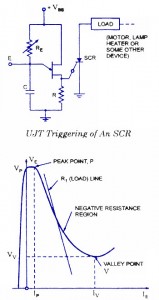How to trigger an SCR using UJT ?

One common application of the uni junction transistor is the triggering of the other devices such as the SCR, triac etc. The basic elements of such a triggering circuit are shown in figure. The resistor RE is chosen so that the load line determined by RE passes through the device characteristic in the negative resistance region, that is, to the right of the peak point but to the left of the valley point, as shown in figure. If the load line does not pass to the right of the peak point P, the device cannot turn on.
For ensuring turn-on of UJT
RE < VBB – Vp / IP
This can be established as below
Consider the peak point at which IRE = Ip and VE = VP
(the equality IRE = IP is valid because the charging current of capacitor, at this instant is zero, that is, the capacitor, at this particular instant, is changing from a charging state to
a discharging state). Then VE = VBB – IRE RE
So, RE(MAX) = VBB – VE / IRE = VBB – Vp / IP at the peak point.
At the valley point, V
IE = IV and VE = VV so that
VE = VBB – IRE RE
So RE(MIN) = VBB – VE / IRE = VBB – VV / IV or for ensuring turn-off.
RE > = VBB – VV / IV
So, the range of resistor RE is given as
VBB – VP / IP >RE > VBB – VV / IV
The resistor R is chosen small enough so as to ensure that SCR is not turned on by voltage VR when emitter terminal E is open or IE = 0
The voltage VR = RVBB/R + RBB for open-emitter terminal.
The capacitor C determines the time interval between triggering pulses and the time duration of each pulse. By varying RE, we can change the time constant RE C and alter the point at which the UJT fires. This allows us to control the conduction angle of the SCR, which means the control of load current.

2 Comments
thank you
some more details in pdf format should be available